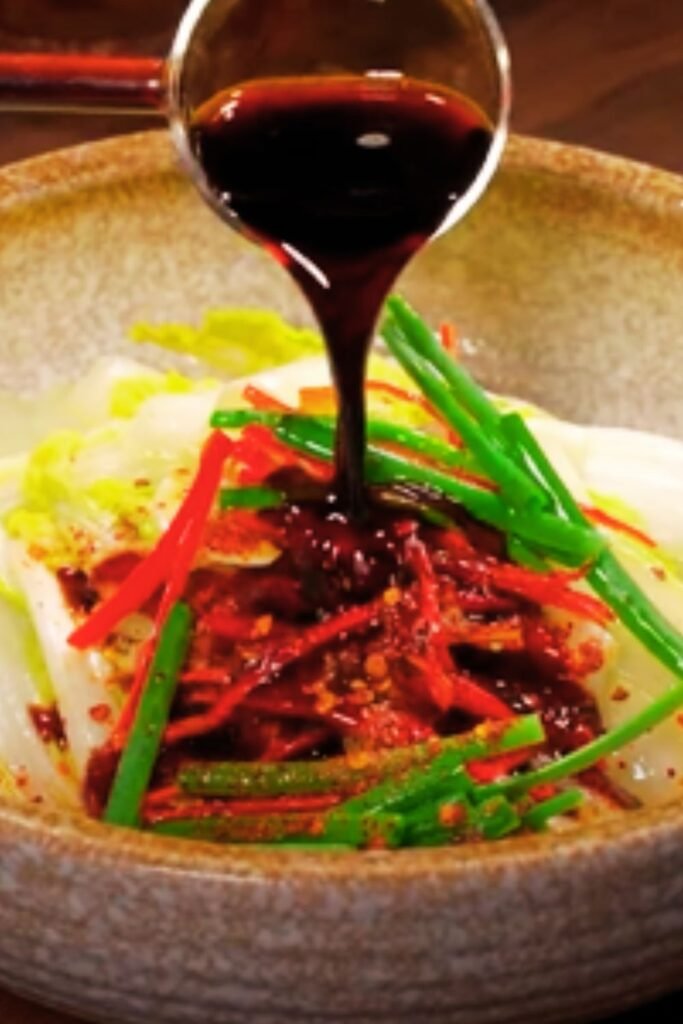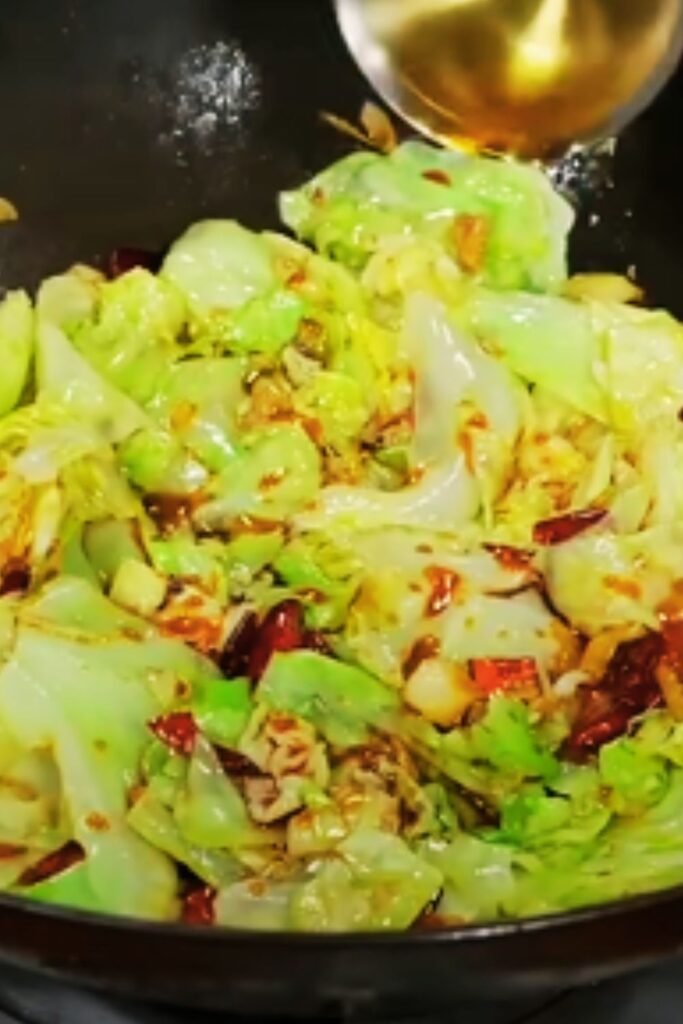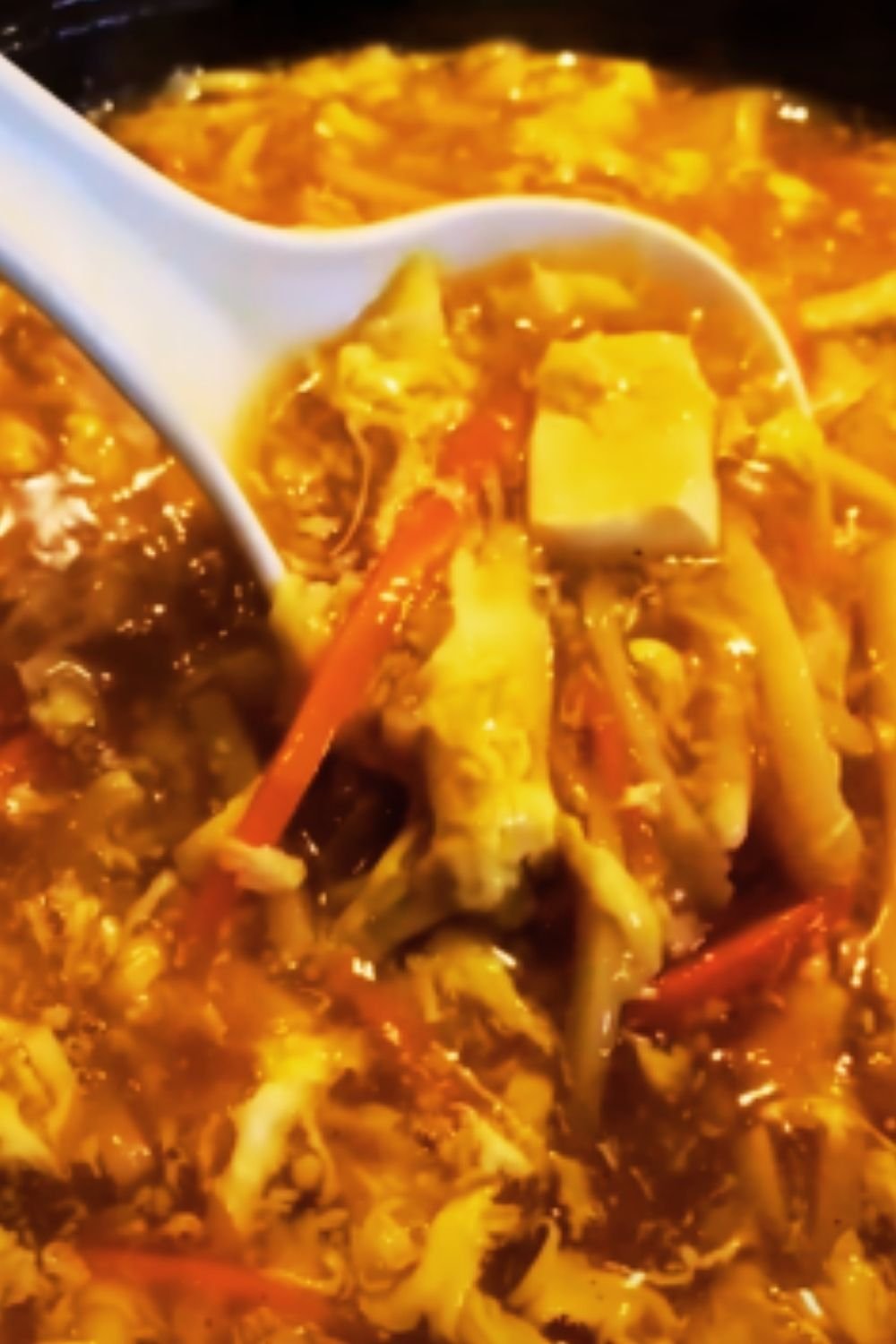There’s something magical about the sizzle of vegetables hitting a hot wok. That distinctive sound takes me back to my grandmother’s kitchen, where I first learned the art of stir-frying. Chinese cabbage, with its delicate leaves and crisp texture, has always been my favorite vegetable to transform into a quick, nutritious meal. Today, I’m excited to share everything I know about creating the perfect Chinese cabbage stir-fry – a dish that’s not only packed with flavor but also incredibly versatile and healthy.
What Makes Chinese Cabbage Special?
Chinese cabbage (also known as Napa cabbage) belongs to the Brassica family and has been a staple in Asian cuisine for centuries. Unlike its rounder Western counterpart, Chinese cabbage has an elongated shape with tightly packed, crinkly pale green leaves and thick white stalks.
What I love most about this vegetable is its dual personality – the leaves cook quickly and soak up flavors beautifully, while the stalks maintain a satisfying crunch even after cooking. This textural contrast makes it perfect for stir-frying.
Types of Chinese Cabbage You Might Encounter
Napa Cabbage (Brassica rapa subsp. pekinensis) : The most common variety, featuring a large oblong head with tightly packed crinkly leaves and thick white ribs. This is what most recipes refer to when mentioning Chinese cabbage.
Bok Choy (Brassica rapa subsp. chinensis) : Sometimes confused with Napa cabbage, bok choy has dark green leaves and white stalks that grow in a loosely clustered formation rather than a tight head.
Baby Bok Choy : A smaller, more tender version of bok choy that can be cooked whole in stir-fries.
Taiwanese Flat Cabbage : A less common variety with a flatter head and milder flavor.
For our stir-fry recipe today, I’ll be focusing on Napa cabbage, but many of the techniques apply to other varieties as well.
Nutritional Powerhouse
Before we dive into cooking, let’s appreciate just how nutritious Chinese cabbage really is. I’ve always believed that healthy eating doesn’t have to sacrifice flavor, and this vegetable proves my point perfectly.
| Nutrient | Amount (per 100g) | % Daily Value | Benefits |
|---|---|---|---|
| Calories | 12 kcal | <1% | Low-calorie food perfect for weight management |
| Vitamin C | 27 mg | 45% | Supports immune function and collagen production |
| Vitamin K | 42.9 μg | 53% | Essential for blood clotting and bone health |
| Folate | 79 μg | 20% | Important for cell division and DNA synthesis |
| Calcium | 77 mg | 8% | Supports bone health and muscle function |
| Potassium | 238 mg | 7% | Helps maintain fluid balance and nerve signals |
| Fiber | 1.2 g | 5% | Promotes digestive health and feelings of fullness |
| Antioxidants | Various | – | Help combat oxidative stress and inflammation |
What impresses me most is how Chinese cabbage delivers so much nutrition with so few calories. It’s particularly rich in vitamin C, providing nearly half of your daily needs in just one serving!
Essential Ingredients for an Authentic Chinese Cabbage Stir-Fry
Creating a truly delicious stir-fry is all about balancing flavors and textures. Here are the ingredients I consider essential:
The Star of the Show
- 1 medium head of Napa cabbage (about 2 pounds)
- 2 tablespoons high-heat cooking oil (peanut, avocado, or grapeseed)
Aromatics (The Flavor Foundation)
- 3 cloves garlic, minced
- 1-inch piece ginger, peeled and julienned
- 2-3 scallions, white parts sliced diagonally, green parts reserved for garnish
- Optional: 1 small dried red chili, seeds removed and thinly sliced
The Sauce (A Perfect Balance of Flavors)
- 1 tablespoon soy sauce (light soy sauce preferred)
- 1 teaspoon toasted sesame oil
- ½ teaspoon sugar or honey
- ¼ teaspoon white pepper
- 1 tablespoon Shaoxing wine or dry sherry (optional but recommended)
Additional Mix-ins (For Added Texture and Nutrition)
- 1 medium carrot, julienned
- 1 red bell pepper, thinly sliced
- 8 fresh shiitake mushrooms, stems removed and caps sliced
- 1 tablespoon toasted sesame seeds for garnish
Preparation: The Key to Stir-Fry Success
I’ve learned through years of cooking that proper preparation is what separates a good stir-fry from a great one. Stir-frying happens quickly, so having everything ready before you start cooking is absolutely essential.
Preparing the Chinese Cabbage
- Remove any wilted outer leaves from the cabbage head
- Cut the cabbage in half lengthwise
- Remove the core by making a triangular cut at the base
- Slice each half crosswise into 1-inch pieces, separating the leafy parts from the stalks
- Wash thoroughly in cold water, then drain in a colander
- Important tip: Pat the cabbage dry with paper towels or use a salad spinner – excess water will create steam and prevent proper caramelization

The Perfect Cutting Technique
One technique that revolutionized my stir-frying is cutting the cabbage to create pieces of similar cooking time. I separate the thicker white stalks from the leafy green portions. The stalks get sliced a bit thinner (about ½-inch) while the leaves can be left in larger pieces (about 1-inch). This ensures everything cooks evenly without the leaves becoming mushy before the stalks are tender.
Cooking Method: Mastering the Wok
While you can make this dish in a large skillet, a wok truly delivers the best results. Here’s my foolproof method for the perfect Chinese cabbage stir-fry:
Step 1: Heat the Wok Properly
This is perhaps the most critical step. A properly heated wok creates that coveted “wok hei” – the unique charred flavor that distinguishes restaurant-quality stir-fries.
- Place your wok over high heat until it just starts to smoke
- Add the oil and swirl to coat the cooking surface
- The oil should shimmer but not smoke excessively
Step 2: Layer the Flavors
Adding ingredients in the proper order builds a foundation of flavor:
- Add the aromatics (garlic, ginger, white parts of scallions, and chili if using) and stir-fry for 10-15 seconds until fragrant but not browned
- Add any additional firm vegetables (carrots, bell peppers) and stir-fry for 1 minute
- Add the mushrooms and stir-fry for another minute
- Add the cabbage stalks and stir-fry for 1-2 minutes until they begin to soften
- Finally, add the leafy parts and toss quickly to combine
Step 3: Master the Tossing Technique
Proper tossing ensures even cooking and prevents sticking:
- Use a scooping motion with your spatula, lifting ingredients from the bottom of the wok
- If using a traditional wok, you can also use a gentle flipping motion (practice makes perfect!)
- Keep the ingredients moving constantly to prevent burning
Step 4: Add the Sauce at the Right Moment
Timing is everything with the sauce:
- When the cabbage leaves have just started to wilt but still maintain some crispness (about 1-2 minutes after adding them), push everything to the sides of the wok creating a well in the center
- Pour the sauce mixture into this well
- Let it bubble for 5-10 seconds
- Quickly toss everything together to coat evenly
Step 5: Final Touches
These last steps make all the difference:
- Toss in the green parts of the scallions
- Drizzle with a little extra sesame oil if desired
- Sprinkle with toasted sesame seeds
- Serve immediately for the best texture and flavor
Common Mistakes and How to Avoid Them
Through many years of making this dish, I’ve encountered (and made) plenty of mistakes. Here are the most common ones and how to avoid them:
Overcrowding the Wok
Perhaps the most common mistake is adding too much cabbage at once. This lowers the temperature of the wok and causes the vegetables to steam rather than stir-fry.
Solution: If cooking for more than 2-3 people, cook in batches. It takes a little longer but delivers far superior results.
Using Too Much Oil
While it’s tempting to add more oil when the wok looks dry, too much oil can make your stir-fry greasy.
Solution: Start with just enough oil to coat the wok. If needed, add a tablespoon of water or broth instead of more oil to create steam and help cook the vegetables.
Not Controlling the Heat
Heat management is crucial for stir-frying. Too hot, and your aromatics burn; too cool, and you’ll end up with soggy cabbage.
Solution: Start with high heat for the aromatics, then adjust as needed. Don’t be afraid to temporarily remove the wok from the heat if things are cooking too quickly.
Not Preparing Ingredients Ahead of Time
Once you start stir-frying, there’s no time to chop or measure.
Solution: Practice “mise en place” – have everything cut, measured, and ready before you turn on the heat.

Variations to Keep Things Interesting
What I love about Chinese cabbage stir-fry is its versatility. Here are some of my favorite variations:
Protein Additions
Adding protein transforms this side dish into a complete meal:
- Tofu: Cut firm tofu into cubes, pat dry, and stir-fry until golden before adding the vegetables
- Chicken: Thinly sliced chicken breast marinated briefly in a mixture of soy sauce, cornstarch, and a splash of rice vinegar
- Shrimp: Peeled and deveined shrimp need only 2-3 minutes of cooking time
- Beef: Thinly sliced flank steak against the grain, marinated similarly to chicken
- Eggs: Push cooked vegetables to the side, scramble 1-2 eggs in the empty space, then mix together
Regional Flavor Profiles
Different regions of Asia bring unique flavors to this versatile dish:
| Region | Key Flavoring Ingredients | Characteristics |
|---|---|---|
| Sichuan | Doubanjiang (spicy bean paste), Sichuan peppercorns | Numbing heat with complex flavor |
| Cantonese | Oyster sauce, fermented black beans | Umami-rich with subtle sweetness |
| Korean-Inspired | Gochujang (Korean chili paste), sesame oil | Sweet, spicy, and smoky |
| Japanese-Inspired | Mirin, dashi, bonito flakes | Delicate umami flavors |
| Thai-Inspired | Fish sauce, lime juice, Thai basil | Bright, aromatic with sour notes |
Sauce Variations
The sauce is where you can really get creative:
- Garlic Sauce: Double the garlic and add 1 tablespoon of black vinegar
- Sweet and Sour: Add 1 tablespoon of ketchup and 1 tablespoon of rice vinegar to the base sauce
- Spicy Sauce: Add 1-2 teaspoons of chili oil or sambal oelek
- Creamy Sauce: Add 2 tablespoons of unsweetened coconut milk at the end
- Nutty Sauce: Add 1 tablespoon of peanut butter to create a richer sauce
Serving Suggestions
Chinese cabbage stir-fry pairs beautifully with so many dishes:
- Steamed jasmine or brown rice
- Noodles (udon, rice noodles, or even spaghetti in a pinch)
- As part of a larger Chinese meal alongside other dishes
- Wrapped in lettuce leaves for a low-carb option
- In steamed buns (bao) with some hoisin sauce
- As a bed for grilled fish or chicken
For a complete meal, I like to serve it with:
- A simple clear soup like egg drop or hot and sour
- Fresh fruit like sliced oranges or Asian pears for dessert
- Unsweetened tea (green, jasmine, or oolong)
Storage and Reheating Tips
While Chinese cabbage stir-fry is best enjoyed fresh, leftovers can still be delicious if handled properly:
- Store in an airtight container in the refrigerator for up to 3 days
- The texture will soften as it sits, but the flavor often improves overnight
- Reheat in a hot wok or skillet rather than the microwave to revive some of the texture
- Add a sprinkle of fresh herbs or a squeeze of citrus after reheating to brighten the flavors
Health Benefits Beyond Basic Nutrition
Chinese cabbage stir-fry isn’t just delicious – it’s also incredibly good for you:
Digestive Health
The fiber in Chinese cabbage supports healthy digestion, while the cooking method preserves more nutrients than boiling or steaming for extended periods.
Anti-Inflammatory Properties
Chinese cabbage contains compounds called glucosinolates that have been studied for their anti-inflammatory and potentially cancer-fighting properties.
Heart Health
The low calorie and fat content, combined with potassium and fiber, make this dish heart-friendly.
Weight Management
High in volume but low in calories, Chinese cabbage stir-fry helps you feel satisfied with fewer calories.
Complete Recipe Card
Here’s the complete recipe for easy reference:
| Chinese Cabbage Stir-Fry | |
|---|---|
| Prep Time: 15 minutes | Cook Time: 7 minutes |
| Total Time: 22 minutes | Servings: 4 as a side, 2 as a main |
| Calories: Approximately 120 per serving | Cuisine: Chinese-inspired |
Ingredients
- 1 medium head Napa cabbage (about 2 pounds)
- 2 tablespoons high-heat cooking oil
- 3 cloves garlic, minced
- 1-inch piece ginger, peeled and julienned
- 2-3 scallions, white and green parts separated, sliced diagonally
- 1 medium carrot, julienned
- 1 red bell pepper, thinly sliced
- 8 fresh shiitake mushrooms, stems removed and caps sliced
- 1 tablespoon soy sauce
- 1 teaspoon toasted sesame oil
- ½ teaspoon sugar or honey
- ¼ teaspoon white pepper
- 1 tablespoon Shaoxing wine or dry sherry (optional)
- 1 tablespoon toasted sesame seeds for garnish
Instructions
- Prepare the cabbage: Remove outer leaves, cut in half lengthwise, remove core, and slice into 1-inch pieces, separating leaves from stalks.
- Wash and thoroughly dry the cabbage.
- Mix sauce ingredients (soy sauce, sesame oil, sugar, white pepper, and Shaoxing wine if using) in a small bowl.
- Heat wok over high heat until just smoking, then add oil.
- Add garlic, ginger, and white parts of scallions. Stir-fry for 10-15 seconds until fragrant.
- Add carrots and bell peppers, stir-fry for 1 minute.
- Add mushrooms, stir-fry for another minute.
- Add cabbage stalks, stir-fry for 1-2 minutes until beginning to soften.
- Add cabbage leaves, toss quickly for 1-2 minutes until just starting to wilt.
- Push everything to the sides, pour sauce in the center, let bubble for 5-10 seconds.
- Quickly toss everything together to coat evenly.
- Add green parts of scallions and toss again.
- Transfer to a serving dish, sprinkle with sesame seeds, and serve immediately.
Kitchen Equipment You’ll Need
Having the right tools makes this recipe much easier to prepare:
- Wok or large skillet (12-14 inches)
- Sharp chef’s knife
- Cutting board
- Small bowl for sauce
- Spatula or wok tool
- Measuring spoons
- Colander for washing vegetables
- Paper towels or salad spinner

Frequently Asked Questions
Q: Can I make this dish ahead of time for a party?
A: While it’s best fresh, you can prepare all the ingredients ahead of time and store them separately. The cabbage can be cut, washed, and dried up to a day ahead (store in the refrigerator with a paper towel to absorb moisture). The aromatics can be prepared up to a day ahead as well. The actual cooking takes just minutes and is best done right before serving.
Q: My cabbage released a lot of water and became soggy. What went wrong?
A: This usually happens when the wok isn’t hot enough or the cabbage wasn’t dried thoroughly after washing. Make sure your wok is very hot before adding ingredients, and use paper towels or a salad spinner to dry the cabbage as much as possible.
Q: Is there a substitute for Shaoxing wine?
A: Dry sherry is the best substitute. If you prefer to avoid alcohol altogether, you can use chicken or vegetable broth with a tiny splash of rice vinegar, or simply omit it.
Q: Can I use regular green cabbage instead of Chinese cabbage?
A: Yes, but the cooking time and texture will be different. Regular cabbage is tougher and takes longer to cook. Slice it very thinly and expect to add a bit more cooking time.
Q: How do I make this spicier?
A: There are several ways to add heat: include thinly sliced fresh chilies with the aromatics, add dried chili flakes or Sichuan peppercorns, stir in some chili oil at the end, or serve with chili sauce on the side.
Q: My stir-fry stuck to the wok. How do I prevent this?
A: This usually happens when the wok isn’t hot enough before adding oil, or when ingredients aren’t kept moving. Make sure your wok is very hot, add enough oil to coat the surface, and keep everything moving constantly.
Q: Can I make this dish vegan?
A: It already is! Just make sure to check your soy sauce ingredients, as some brands contain fish extract.
Q: How do I make this low-sodium?
A: Use low-sodium soy sauce and reduce the amount to 2 teaspoons. You can add a splash of rice vinegar to brighten the flavor without adding sodium.
Final Thoughts
Chinese cabbage stir-fry may seem simple, but it’s a dish that rewards attention to detail. The techniques I’ve shared here – from proper preparation to heat management – apply to virtually all stir-fries. Master this versatile dish, and you’ll have a quick, nutritious meal option that can be adapted endless ways.
What I love most about this recipe is how it transforms an humble vegetable into something truly special. The contrast between the crisp stalks and tender leaves, the balance of savory soy and aromatic sesame oil, and the bright colors of the added vegetables make it as beautiful as it is delicious.
So the next time you see Chinese cabbage in your market, grab a head and give this stir-fry a try. Your taste buds – and your body – will thank you!


